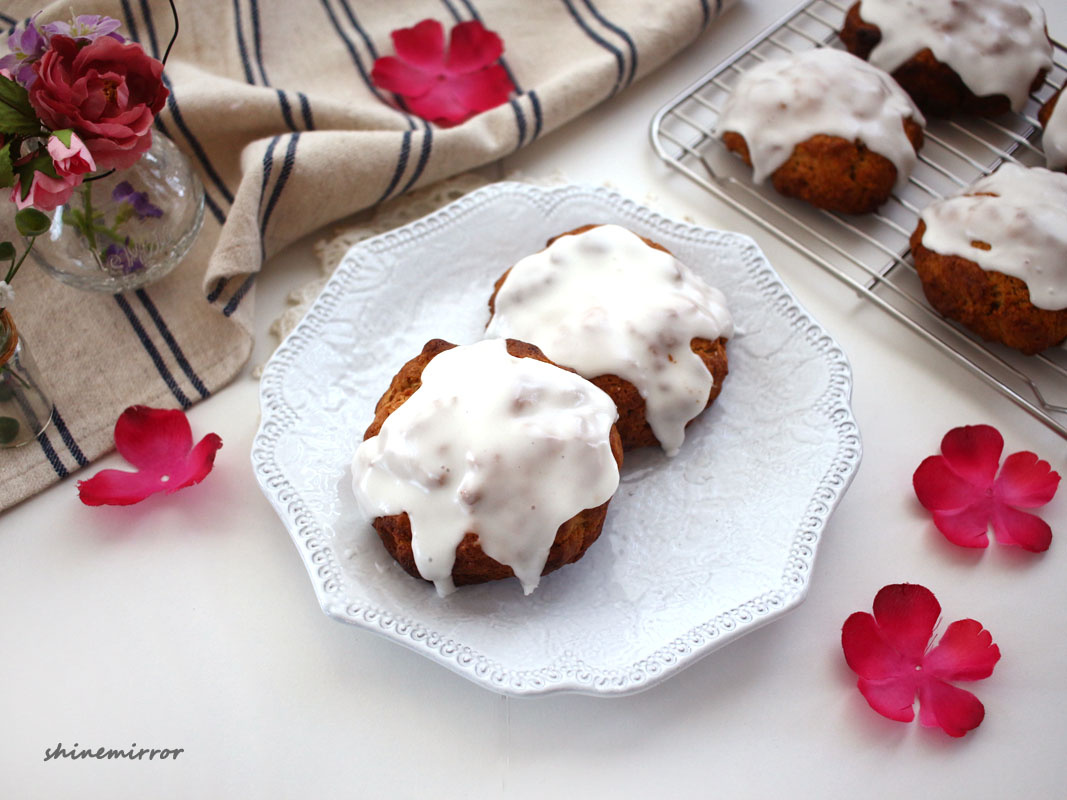Zesty Lemon Dill Butter Scones
Homemade Aromatic Lemon Dill Scones :: Utilizing Lemon Dill Butter

Did you also make lemon dill butter last winter and wonder how to use it up? If it’s been sitting in your freezer after a few toastings, this recipe is the perfect way to transform it into delicious scones! While the dill flavor is subtle, the bright, refreshing lemon aroma fills your mouth, making these scones exceptionally delightful. You can create a wonderful homemade dessert without needing any special ingredients. Shall we start making these fragrant Lemon Dill Scones right away?
Scone Dough- 200g cake flour (low-gluten flour)
- 100g cold lemon dill butter, cubed
- 60g muscovado sugar (adjust to taste)
- 2g salt
- 4g baking powder
- 2g baking soda
- 25g fresh lemon juice
- 50g cold heavy cream (over 35% fat recommended)
Lemon Icing- 22g fresh lemon juice (for consistency adjustment)
- 110g powdered sugar (sifted)
- 22g fresh lemon juice (for consistency adjustment)
- 110g powdered sugar (sifted)
Cooking Instructions
Step 1
First, in a small bowl, combine the cold heavy cream and 25g of fresh lemon juice. Whisk them gently with a whisk or fork until smoothly blended. This mixture will add moisture and flavor to your scone dough.

Step 2
In a food processor (or a large bowl), add the cake flour (200g), muscovado sugar (60g), salt (2g), baking powder (4g), and baking soda (2g). These dry ingredients are the foundation for the scone’s taste and texture.

Step 3
Briefly pulse the food processor a few times, or if using a bowl, stir lightly with a spatula to combine the dry ingredients evenly. Ensuring there are no lumps is important for a consistent bake.

Step 4
Now, add the cold lemon dill butter, cut into approximately 1-1.5cm cubes, and scatter it evenly over the dry ingredients. Keeping the butter cold is crucial for achieving flaky scones, so avoid letting it melt.

Step 5
If using a food processor, pulse it intermittently, breaking the butter into the flour mixture. Continue until the butter pieces are about the size of small rice grains and are evenly distributed within the flour. Be careful not to over-process, as melted butter can lead to tough scones. (If using pre-made and frozen lemon dill butter, thaw it in the refrigerator before use, but ensure it remains cold.)

Step 6
Once the butter is finely cut and mixed with the dry ingredients, pour the prepared cream and lemon juice mixture (25g) evenly over the dough.

Step 7
Pulse the food processor again briefly, or use a spatula to gently mix the wet and dry ingredients until just combined. Stop mixing as soon as the ingredients form a moist dough. Overmixing can develop gluten and result in tough scones.

Step 8
Turn the dough out onto a work surface and gently bring it together into a cohesive ball. Wrap it tightly in plastic wrap and refrigerate for at least 1 hour. This chilling period allows the butter to firm up again and the dough to rest, leading to a better scone texture.

Step 9
After chilling, divide the dough into approximately 6 equal portions, each weighing about 70-75g. Gently flatten each portion with your palm to form a round shape about 1.5-2cm thick, or your desired scone shape. Place them on a baking sheet with some space between them. Avoid making them too thin, as they can become dry.

Step 10
Brush the tops of the scones with a little extra heavy cream (not listed in ingredients) using a pastry brush. This will help create a golden-brown and appealing finish when baked.

Step 11
Bake in a preheated oven (Smeg oven set to 180°C or 350°F) for about 20 minutes, or until the tops are golden brown. Immediately after removing from the oven, transfer the baked scones to a wire rack. Let them cool slightly on the rack so the bottoms don’t become soggy.

Step 12
To make the icing, combine the 22g of lemon juice and 110g of sifted powdered sugar in a small bowl. Stir well. The amount of lemon juice may need adjustment depending on the type of powdered sugar and humidity, so add it gradually until you achieve your desired consistency. A slightly thinner icing is easier to drizzle without a piping bag.

Step 13
While the scones are still slightly warm, use a spoon or the back of a whisk to drizzle the lemon icing over the scones, allowing it to drip naturally down the sides. This method is easy and reduces cleanup (no piping bag needed!). Let the scones sit in a cool place until the icing is completely set. Enjoy your delicious Lemon Dill Scones!




